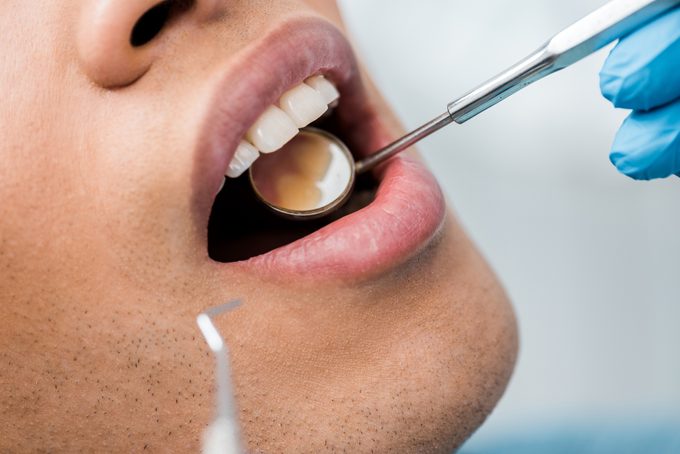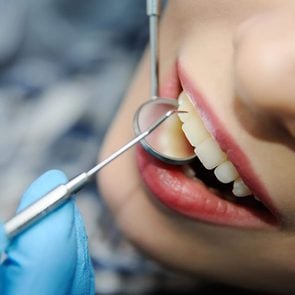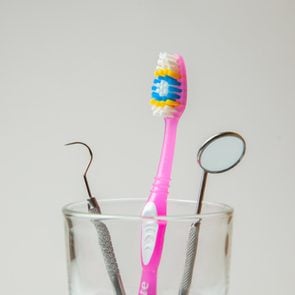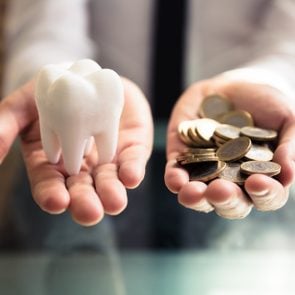4 Ways Covid-19 Is Bad for Your Teeth, According to Dentists
Updated: Mar. 14, 2022
Dentists reveal how the Covid-19 pandemic is leading to tooth problems—from gum disease to cracked teeth to cavities—and how to get your oral health back on track.
The Covid-19 pandemic has changed daily life and the way people think about public health. The uncertainty of the novel coronavirus and its effects has led to an uptick in stress, depression, anxiety, and other mental health issues. Sometimes, these issues can manifest themselves in unconscious behaviors, like teeth grinding and jaw clenching, which can lead to bad teeth.
When you’re stressed during the day, your body can react by causing you to grind your teeth at night, often without realizing it, says Derek T. Peek, DDS, a board-certified endodontist in Cedar Rapids, Iowa. This puts pressure on the mouth and can result in an array of oral health issues.
Dental problems also may be on the rise because some people may be putting off going to the dentist. At the height of the Covid-19 pandemic, stay-at-home orders and temporary closures at dental offices led to a decrease in the number of patients pursuing dental services. According to a survey of more than 19,000 dentists by the American Dental Association Health Policy Institute, nearly 95 percent said they were closed or open only for emergency patients in the last week of March.
However, the ADA survey shows there was a gradual uptick in the number of people going to the dentist each month. By early August, more than half of dentists said their offices were open, but they were seeing a lower-than-normal volume of patients. When patients do return, dentists, like Dr. Peek, are noticing trends in the types of dental problems likely brought on by the pandemic.

Cracked teeth
The cases of cracked teeth treated in the months of August and September doubled, despite dentists seeing fewer patients compared to 2019, according to Dr. Peek. This was when his practice wasn’t limited due to coronavirus restrictions. Dr. Peek attributes this increase to stress caused by the pandemic, with more people grinding their teeth while they sleep.
“In pretty much every case of cracked teeth, usually in interviewing the patient, you find some stressor,” he says. “I think we’re living in times that are more stressful for everybody. I would probably just boil it down and say stress. People don’t know if they’re going to have a job, when they can be social again, or for how long they’ll have to homeschool. There’s a big ol’ ball of stress out there that’s bigger than it’s been and that’s probably what’s causing people to break their teeth more.”
Types of cracks
Dr. Peek says teeth grinding at night puts pressure on the mouth and can result in several types of cracks: vertical root fracture, craze lines, split tooth, fractured cusp, or cracked tooth. He says some of these are asymptomatic, and the patient won’t realize they have a crack until they go in for a routine cleaning. In other cases, patients will complain of swelling, pain when they chew, lingering pain, or the feeling that a tooth is loose.
If you’re experiencing similar symptoms, see your dentist. Treatment depends on the type of crack and severity. Avoiding treatment and skipping your regular dental check-ups is a habit that can result in bad teeth.
“We take a look at the condition the tooth is in: Has it had a root canal? Does it have a crown?” says Dr. Peek. “It’s not one easy cookbook thing. The majority of the time you come to a treatment plan for each individual, and you do your best to keep their teeth in her mouth. That’s what endodontists do. Our job is to do everything we can to keep your teeth in your mouth.”
Gingivitis
There’s so much more to your oral health than just your teeth. Case in point: Your gums.
Todd Ross, DDS, adjunct clinical assistant professor at NYU College of Dentistry, says that the issue he’s seeing in more patients is acute periodontal disease, which includes gingivitis (inflammation of the gums), bleeding gums, and tartar buildup. He attributes this to patients skipping regular checkups since the onset of Covid-19. He also says many patients may not be keeping up with their typical oral hygiene practices.
“It is perfectly understandable that patients are hesitant to return for regular dental treatment, however, if you are in a state with a low Covid-19 rate, according to the [Centers for Disease Control and Prevention], you should consider seeing the dentist,” says Dr. Ross. “All the dentists I know are practicing social distancing and extreme preventive measures in their offices to ensure the safety of their patients and staff. These measures include temperature checks, medical histories, special ventilation systems, wearing N-95 masks, in addition to face shields, repetitive hand sanitation, and pre-peroxide rinses.”
Aside from dental cleanings, gingivitis can be helped (and prevented) by using an anti-plaque mouthwash and regular brushing and flossing.
Tooth decay and cavities
Across the board, the dentists we spoke to attributed many of the prevalent problems they are seeing in terms of oral health right now to limited access to dental care and mixed messages about whether it’s safe to receive treatment.
Elliott Maser, DDS, clinical associate professor of pediatric dentistry at the University of Pennsylvania, says he has seen more areas of decay that have progressed because of lack of treatment.
Tooth decay occurs when the bacteria that exist in the mouth produce enamel-attacking acid. “Part of this is due to the restrictions placed on the dental community during the first several months of the Covid-19 pandemic in terms of treating patients,” says Dr. Maser. “We are working on a more limited workload because of the precautions taken in the office in terms of cleaning, filtering the air, the more stringent sterilizations techniques that require the dental team to a lot more time per patient, and decrease the patient load.”
As previously mentioned, people are encouraged to schedule routine cleanings and checkups, assuming state and local guidelines allow for them. Additionally, they are encouraged to pay particularly close attention to their daily oral hygiene habits, brushing and flossing carefully to reduce the potential for decay and cavities.
Bruxism
At his practice in Manhattan Beach, California, Joel Gould, DDS, says he’s seeing many more patients with bruxism, which is simply defined as grinding your teeth. Dr. Gould says bruxism can result in headaches, jaw stiffness, facial pain, and the wearing down of teeth, which in turn might create tooth sensitivity when eating or drinking. This is often grouped under the umbrella of a a temporomandibular joint and muscle (TMJ) disorder, which includes pain in your jaw joint and the muscles around it.
The issue is commonly linked to stress, anxiety, and sleep disorders, as addressed in a 2019 study published in Open Access Macedonian Journal of Medical Sciences. Because of this, treatment for bruxism may include cognitive behavioral therapy, or a mouth guard to help with sleep bruxism.
A vitamin D deficiency
However, after studying bruxism extensively, Dr. Gould believes the condition is a result of a vitamin D deficiency.
“It makes sense that more people would bruxism these days,” he explains. “People are locked down and they’ve lost their casual sun exposure walking from their car to the office, going for lunch, everyday things we aren’t doing right now. Vitamin D regulates a lot of different things in our body. When you don’t have enough, symptoms may include a combination of insomnia, anxiety, and bruxism.”
A 2019 study in the Journal for International Medical Research found that patients with TMJ were more likely to have a vitamin D deficiency.
Dr. Gould strongly recommends taking the opportunity to spend some time outside, at least a couple of times during the day. This will help increase vitamin D production. As he explains, vitamin D isn’t a vitamin at all. Rather, it’s a hormone produced by the kidneys to control calcium levels in the blood.
“You only make vitamin D between certain times of the day,” he says. “Look at a fire hydrant and observe whether its shadow is longer than the height of the object. If that’s the case you’re no longer making vitamin D. The sun has to be higher up in the sky to be able to cast a shadow that’s shorter than your height. That’s when you know the sun is strong enough to make vitamin D.”
The takeaway
The Covid-19 pandemic has caused a notable change in how many people look after their oral health. Aside from brushing and flossing, teeth may be low on the priority list compared to the rest of your body. However, poor oral hygiene can lead to poor health and increase the likelihood of health issues like type 2 diabetes and heart disease. Therefore, it’s crucial to visit your dentist twice a year or as often as you need to. If you’re going to the dentist during the pandemic, follow these hygienist tips to know what to expect during your next visit.



